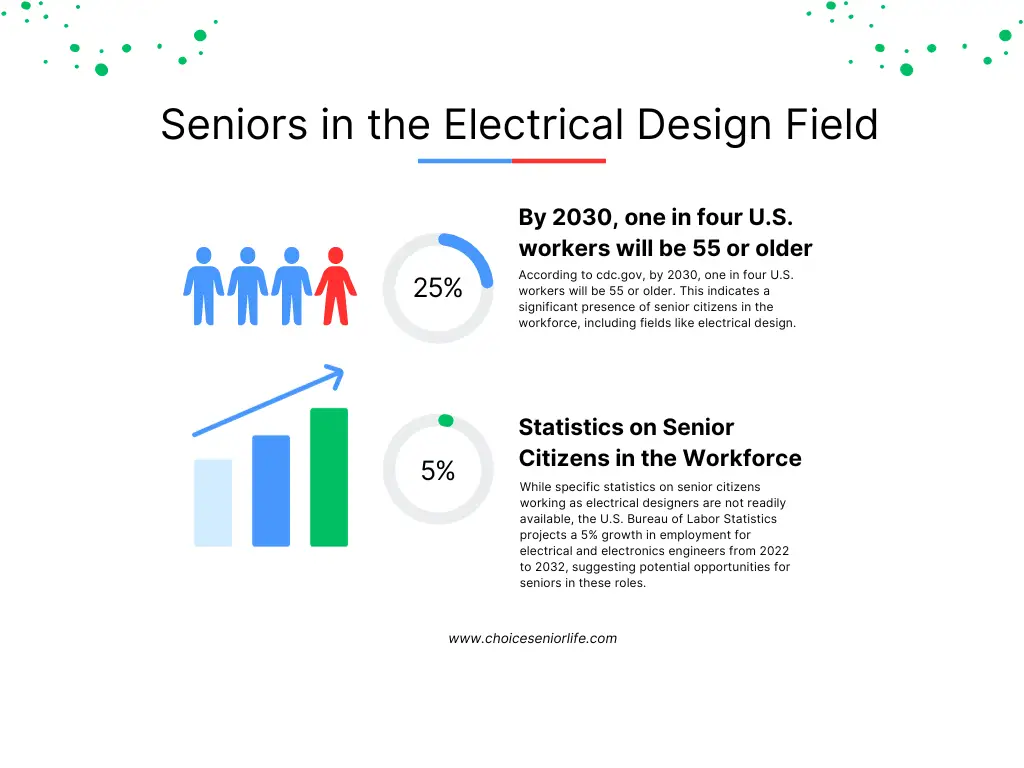When the concept of retirement is continuously evolving, more senior citizens are choosing to remain active in the workforce. Among these, a unique and intriguing group are those who work as electrical designers. This article, backed by the latest statistics, sheds light on the presence and impact of senior citizens in this dynamic field. We invite you to share your experiences and thoughts on this trend.
The Role of Electrical Designers
Explanation of Electrical Design and its Importance
Electrical design is a critical component of modern engineering, involving the creation of electrical systems for various applications. From residential buildings to complex industrial machinery, the work of electrical designers is foundational to our technologically driven world.
Common Responsibilities of Electrical Designers
These professionals are tasked with developing electrical systems, ensuring safety standards, and innovating solutions for electrical challenges. Their role demands a deep understanding of electrical theories, practical application, and adherence to regulatory requirements.
Skills and Qualifications Required for the Role
Typically, electrical designers hold a degree in electrical engineering or a related field. Key skills include analytical thinking, problem-solving, and proficiency in design software. For senior citizens, their extensive experience often adds a layer of depth to these qualifications.
Statistics on Senior Citizens in the Workforce

General Employment Trends for Senior Citizens
According to cdc.gov, by 2030, one in four U.S. workers will be 55 or older. This indicates a significant presence of senior citizens in the workforce, including fields like electrical design.
Overview of Senior Citizens in the Design and Engineering Fields
While specific statistics on senior citizens working as electrical designers are not readily available, the U.S. Bureau of Labor Statistics projects a 5% growth in employment for electrical and electronics engineers from 2022 to 2032, suggesting potential opportunities for seniors in these roles.
Factors Influencing Senior Citizens in Pursuing Electrical Design Careers
Economic Factors
For many seniors, financial stability is a key motivator. The competitive salaries in electrical design can be a significant draw.
Personal Motivations and Interests
A passion for engineering and design, coupled with a desire for intellectual stimulation, often drives seniors towards this field.
Impact of Changing Retirement Patterns
As retirement norms shift, many seniors view this phase as an opportunity to explore new or longstanding interests in fields like electrical design.
Challenges and Opportunities
Challenges Faced by Senior Citizens in the Workforce
Ageism, keeping up with technological advancements, and physical demands can be challenges for senior electrical designers.
Opportunities and Benefits of Senior Citizens in Electrical Design
Their experience can lead to enhanced problem-solving skills, mentorship roles, and a unique perspective on design challenges.
Workplace Adaptations and Accommodations for Senior Employees
Companies are increasingly recognizing the need for flexible work arrangements and ergonomic workspaces to accommodate senior employees.
Conclusion
The involvement of senior citizens in the electrical design field is a testament to the evolving nature of work and retirement. Their contributions enrich the industry, blending experience with innovation. We’d love to hear your views or stories about senior professionals in this field. Share your thoughts and experiences in the comments below!

Morgan Elfman is a compassionate writer, dedicated caregiver, and passionate advocate for senior well-being. Born and raised with a deep sense of empathy and a natural inclination towards service, Morgan has devoted her life to making a positive impact on the lives of seniors.
As a writer for www.choiceseniorlife.com, Morgan utilizes his skills to create insightful and informative content that addresses the unique needs and challenges faced by seniors and their families. Her articles not only provide valuable information on health, lifestyle, and care options but also strive to inspire and empower seniors to lead fulfilling lives.

